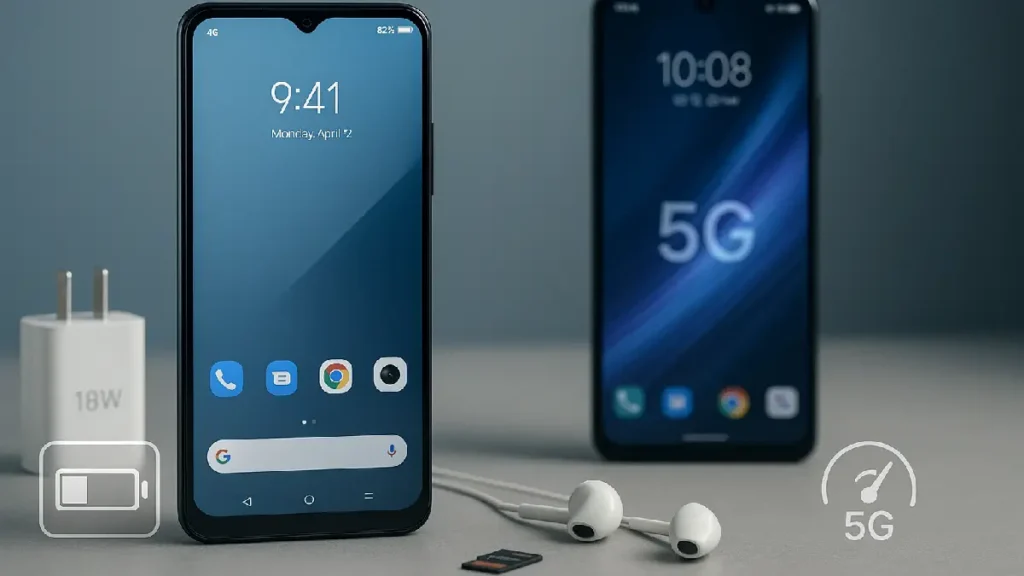If the Vivo Y31 were a hatchback, it would be the dependable model that quietly did everything “fine” in 2021—and then watched the highway shift to faster lanes while it kept the same engine. The question isn’t whether the Y31 was good; it’s whether it’s still defensible to pick one up today when budget 5G phones, longer battery warranties, and fresher Android builds are crowding the shelf. This is a clear-headed guide to when the Y31 still makes sense—and when it really doesn’t.

What the Y31 Still Gets Right
Battery and Efficiency
- The 5,000 mAh pack paired with a 1080p LCD and a frugal Snapdragon 662 remains an all-day combo for calls, maps, messaging, and YouTube at moderate brightness. It’s not flashy, but real-world endurance is exactly the reason many people kept theirs for years.
Everyday Usability
- A clean 6.58-inch FHD+ screen, a usable 48 MP main camera in daylight, a side fingerprint reader that’s fast, dual SIM, microSD expansion up to large capacities, and a 3.5 mm jack. For some workflows—field staff, backup phone, parents—these basics matter more than refresh rate bragging rights.
Thermal and Performance Stability
- The 11nm Snapdragon 662 isn’t fast by 2025 standards, but it’s consistent. For WhatsApp, UPI payments, banking apps, e-mail, Maps, and food delivery, it feels fine provided there’s no heavy multitasking or gaming.
Where It Struggles in 2025
Software Longevity
- The Y31 launched with Android 11 and Funtouch OS 11. By late 2025, most units will be at or near the end of major update eligibility, and even security patches may be sporadic. That’s a meaningful risk for banking, authentication, and BYOD compliance.
Camera Limitations
- The 48 MP sensor is serviceable in daylight, but low light shows its age: slower focus, more noise, and aggressive smoothing. If night photos or indoor shots matter, newer budget 50 MP sensors with modern image pipelines deliver visibly better results.
Charging Speed and Wear
- 18 W charging is tolerable, but with larger batteries now common and 30–45 W standard in budget 5G phones, topping up is slower than peers. Over multiple years, that time tax adds up.
Value Erosion Versus 5G Entrants
- Even if local 5G isn’t a must, the new wave of entry 5G phones brings faster CPUs, UFS storage, better haptics, brighter 120 Hz panels, and longer Android support windows—at equal or slightly higher street prices. That erodes the Y31’s price-performance case.
When Buying the Y31 Still Makes Sense
Tight Budget or Trusted Refurb
- If the price is meaningfully below current entry-5G rivals and the unit is in excellent condition (battery health, clean IMEI, intact charging port), it’s still a practical communications device.
Single-Purpose or Fleet Use
- For POS terminals, delivery apps, kiosk duty, or as a road-trip hotspot/backup, the stability and battery life can be more valuable than raw speed.
Minimalist Daily Patterns
- Calls, texts, light web, and maps, no gaming, no night photography—keep expectations aligned and it holds up.
Alternatives Worth Considering
New Budget 5G Models
- Typically offer 120 Hz displays, brighter panels outdoors, faster chips, longer OS support, and quicker charging. Even without 5G needs, the responsiveness and longevity uplift are noticeable.
Recent Used Midrange Phones
- A 2023–2024 midrange handset often outclasses a 2021 budget device on cameras, updates, and storage speed while costing similar in the second-hand market.
A Simple Buying Checklist
- Battery capacity ≥5,000 mAh
- Charging ≥30 W
- At least two future Android versions guaranteed
- Quarterly security patch cadence
How to Vet a Used Y31
Battery Health Test
- Run a day of typical use (4G data on, 2 hours video, maps, camera) and check if it ends above 30%. If not, budget for a battery replacement.
Ports and Storage Check
- Wiggle test the USB-C port for looseness. Run a storage speed test—if write speeds are unusually low, app installs and camera saves will feel sluggish.
Camera Quick Trial
- Try night mode on a face and on street signage. If focus hunts or noise blotches skin/letters, expect unreliable night shots.
Update Status Review
- Settings → Software update: If security patches are more than six months old, assume limited support going forward.
The Contrarian Verdict
If the Vivo Y31 is cheaper than the shiny alternatives by a meaningful margin and the use case is intentionally modest, it’s still a rational purchase in 2025—boring in the best way. But for most buyers who keep phones 2–4 years, the calculus has flipped: newer budget 5G devices deliver longer software life, faster daily performance, and better cameras for roughly the same outlay. In other words, pick the Y31 only on purpose, not by inertia.




